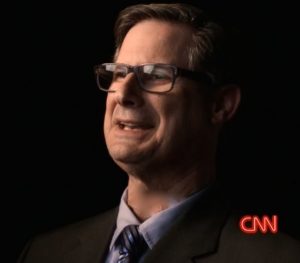
You may recognize Ken Levine as a popular culture commentator on CNN’s recent series The Eighties. His expertise comes from decades as a writer for shows like MASH, Cheers, Frasier, and The Simpsons, just to name a few. Levine also writes a daily blog laced with insight, wit, and a refreshing bit of snark that focuses mainly (although not exclusively) on the entertainment business. Time Magazine named it one of the Best 25 Blogs of 2011. A post from not long ago may strike a chord with any mystery writer who has ever wondered how to make The Big Score and spin prose into Hollywood gold. Here’s a re-post of that blog.
HOW TO CREATE A HIT NETWORK DRAMA
Fame and riches can be yours! Procedural/action dramas are in and you too can create one if you just follow these very simple steps:
Always start with a couple. He must be boyishly handsome and she must be smoking hot. You can go “mature” but then one has to be an established television star, and the other has to be a J. Crew model. In rare cases you can go “both mature” (CSI: New York) but then one has to be a former movie star and the other has to be an established television star who’s had a lot of work done. A LOT of work done.
In the (many) scenes that the couple is together there must be equal parts forced banter and equal parts technical gobbledeegook that no one can understand.
You must have three or four attractive yet quirky support characters. Their primary function is comic relief, paperwork, and shameless exposition. Every other line should begin with, “Bingo! It seems our suspect has three priors for assault, two for armed robbery, and one for libel.”
Each week our “team” must solve a baffling murder case. Guy shot with 30-year-old bullet. Girl freezes to death in the Mojave Desert. Beverly Hills housewife found dead at Ross For Less.
Their headquarters must be sleek, state-of-the-art, something out of The Jetsons. There must be windows galore. I thought I had seen it all when patient rooms were all glass on House (people could just walk by as the nurse was changing your bedpan), but this week Body of Proof went them one better. Dana Delaney (established television star, so network approved) performed an autopsy in a glass-enclosed room with floor-to-ceiling windows to the outside along one wall. Folks can just stroll by, eating that Snickers bar from the vending machine as the coroner lays out and tags Jane Doe’s entrails. I’m waiting to see this trend extend to a sperm bank. “Okay, Mr. Johnson, you just go into that glass cubicle and fill up this cup.”
It’s sometimes best if your team has its own name. That way you can make up its responsibilities. “We only solve murders that were committed between 1987 and 2003.” “We only solve murders of rich people who live on estates that are no less than 65 acres.” “We only solve bite wound crimes.” To avoid audiences saying, “No agencies like that exist,” you’re encouraged to just make up a name and assume characters in your show all know it. The Mentalist works for CBI – the California Bureau of Investigation. They have jurisdiction over… I dunno, police forces or sheriff’s departments. Just wing it. When your lead confronts a suspect and says, “Halt! CBI!”, he’s allowed to be terrified and not say, “CBI? What the fuck is that?” Recently on Hawaii Five-O, McGarrett wanted to question someone we were told was a tourist from the mainland. The guy seems him and is immediately wary. McGarrett says, “Wanna talk to you. I’m from Five-O.” Hearing “Five-O,” the guy flees. A tourist is supposed to know what “Five-O” means? On the show itself they established it was a name they JUST MADE UP. And now it’s so famous, visitors from Dubuque know it. So just pick three letters. Or one number and one letter.
If your series is set in a lab it must have $5,000,000,000 worth of equipment, even if the lab is at a community college. If it’s a police station they must have computer capability to track anyone, break into any city grid, and retrieve information at a second’s notice. There must be surveillance cameras everywhere – jungles included.
Very early on, uncover a suspect who appears to all the world to be the killer. He hated the victim, it was his knife in the guy’s chest, there’s surveillance video showing him do it, he just got out of prison for committing the exact same murder with the exact same M.O. 20 years ago, and when they pick him up he’s in bed with the victim’s wife, reading the life insurance policy while banging her.
Big twist that no one can see coming: He is not the killer.
Suspect number two is discovered. The team finds him hanging out in some public place. The second they identify themselves as Five-O or Ice-9 or WTF he takes off. You must now have your obligatory chase scene. If your star is a “mature” you are allowed to have one of the support goons go after him. Usually there are some shots volleyed. Very exciting. The perp is tackled, handcuffed, dragged into HQ, and it turns out he’s not the guy either. Don’t worry that people are going to say, “Then why did he run?” It’s the only action in the show. They not only buy it, they’ve come to expect it.
So now you’re back to square one. Everyone is baffled. Your star says, “I don’t know. There’s something we’re missing.” A co-worker will walk by and say something innocuous like, “Anyone see my coffee mug?” And a light bulb will go on over the star’s head. “Mug! That’s it!” He uses that fragment to solve the case and lead us to the real killer. Now this is important. You must set up this killer by showing him early and establishing him as the least likely person in the entire world to do such a thing. He’s mending butterfly wings. That way, when it turns out to be him it’s this major surprise – the shock ending no one ever could have predicted.
How do you ultimately explain the baffling murders? Any way you want to. The frozen guy was dumped off by an ice cream truck. The 300-year-old bullet was sold by Larry King, who originally bought it when it was new.
You’re still not done though. You must have the scene where the stars report back to the widow/mother/brother that they got the killer. Closure has been achieved. The star is hugged. He smiles. It’s all worth it.
But is he happy? Oh no. The last scene should be a beauty shot of the hero heading home alone at night. He comforts others but he himself is very lonely. A John Mayer song plays. Very moody. The camera pulls back (big crane shot), and you’re out. Not a dry seat in the house.
That’s it. Follow those rules and we’ll see you next May at the upfronts. I want shared creator credit.
—by Ken Levine
 Ken Levine is an Emmy-winning writer/director/producer/major league baseball announcer. In a career that has spanned over 30 years, Levine has worked on M*A*S*H, Cheers, Frasier, The Simpsons, Wings, Everybody Loves Raymond, Becker, Dharma & Greg, and has co-created his own series including Almost Perfect starring Nancy Travis. He and his partner wrote the feature Volunteers. He has also been the radio/TV play-by-play voice of the Baltimore Orioles, Seattle Mariners, San Diego Padres. and has hosted Dodger Talk on the Dodger Radio Network. He is also the author of the novel Must Kill TV, a deadly satire of network television.
Ken Levine is an Emmy-winning writer/director/producer/major league baseball announcer. In a career that has spanned over 30 years, Levine has worked on M*A*S*H, Cheers, Frasier, The Simpsons, Wings, Everybody Loves Raymond, Becker, Dharma & Greg, and has co-created his own series including Almost Perfect starring Nancy Travis. He and his partner wrote the feature Volunteers. He has also been the radio/TV play-by-play voice of the Baltimore Orioles, Seattle Mariners, San Diego Padres. and has hosted Dodger Talk on the Dodger Radio Network. He is also the author of the novel Must Kill TV, a deadly satire of network television.
